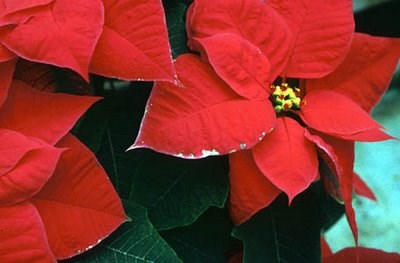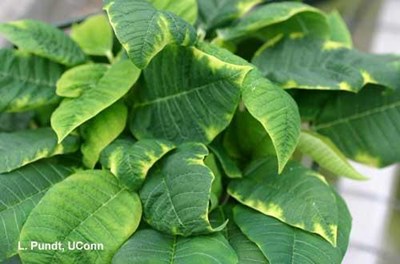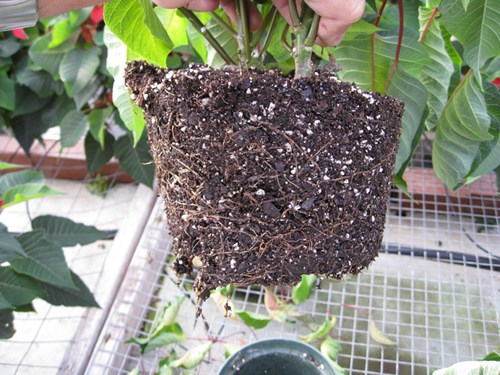Growing Tough Crops: Poinsettias


Poinsettia season will be upon us before we know it. It is never too early to review the needs of a crop and look back at what worked and did not work last year so this year’s crop will be of higher quality and hopefully less stressful to produce. Poinsettias take more time to finish than spring crops, making them a tough crop to grow as more problems are likely to occur. Therefore, an ounce of prevention is worth a pound of cure.
Here are some points to review as you plan out your poinsettia production:
Know Your Poinsettia Varieties
Know the growing requirements for the poinsettia varieties that you are planning to grow. Not all varieties require the same growing environment, and some may be better suited for your greenhouse environment than others. As you plan on what to grow, do not let the potential sale of the finished product make all the decisions for you, but consider growing varieties that you can produce successfully.
Growing Media
Research suggests that poinsettia growing media should be well-drained and well-aerated. Most professional growing media for poinsettia production have high porosity, such as the PRO-MIX® HP product family. The growing medium should hold enough available water and nutrients to facilitate optimum plant growth but drain well to minimize root disease problems. Water holding capacity is of the utmost importance. The growing medium should be physically stable for the duration of the crop.
Controlling growing medium pH and EC depends on the lime charge, media components, water quality, fertilization selection, irrigation practices, growing environment and stage of plant growth. It is essential to monitor growing media pH and EC frequently with both weekly in-house testing and through sample submission to a reputable horticultural laboratory every three weeks. Laboratory testing will not only verify in-house testing but also show the levels of all individual elements within the growing medium that comprise the EC and affect pH. It is recommended that the first laboratory analysis be conducted two weeks after potting. By this time, the lime and other media additives will have had time to react for a truer picture of the root zone chemistry.
Water Quality
Two weeks before potting up your poinsettia crop, send a sample of your water for a comprehensive analysis of the alkalinity, EC, pH, nutrients and other potential problematic elements. If you have multiple water sources, send a sample from each source for analysis.
Water quality has a direct influence on the pH and availability of nutrients in the growing medium and on proper fertilizer selection. Since poinsettias are long-term crops, the grower must supply all necessary nutrients for optimum plant growth. Selection of fertilizer must be made with water quality, plant needs, stage of growth and interaction with the growing medium in mind.
Fertilization
Poinsettias have four stages in which fertilization needs vary. These stages are propagation, initial growth stage, rapid growth stage and the flowering stage. Research shows the amount of fertilizer taken up by plants is higher when the crop’s growth rate is rapid. There are several fertilizers labelled as “poinsettia fertilizers” to make the selection process appear easier from a marketing point of view. However, this does not necessarily make them the most suitable ones for your operation. Because irrigation water, growing media and other management practices can vary significantly from greenhouse to greenhouse, the best fertilizer programs, when matched with these differing situations, should vary also.
A fertilization program should consider some general nutritional guidelines such as: providing the correct amount of acidification or buffering to maintain a correct growing medium pH, correct ratios of phosphorus to nitrogen and potassium to nitrogen, avoiding excessive phosphorus to minimize plant stretch, supplying adequate calcium, magnesium and micronutrients (especially molybdenum) to name a few. One fertilizer formulation may not be able to meet all the needs of your crop, so there may be a need to supplement with additional fertilizer components, like Epsom salts, calcium nitrate or a micronutrient package.


Contact your fertilizer manufacturer for help with selecting the best fertilization program for your specific growing situation. Premier Tech Grower Services team can also help assist in this area as well.
Target pH
Target pH levels for poinsettias are broad – ideally between 5.6 and 6.4 - because poinsettias are not as sensitive to media pH issues as geraniums and petunias. At the extremes, however, symptoms of micronutrient deficiency or toxicity can occur.
Nutrient Deficiencies
Common nutrient deficiencies to watch for are nitrogen, potassium, molybdenum, calcium, magnesium and other general micronutrients. Some of these nutrient problems, especially calcium, may be linked to the time of year when poinsettias are grown (when day length and light intensity are decreasing). Regular in-house testing of growing medium pH and EC can assist, as previously mentioned, in catching problems before they result in damaging deficiency or toxicity symptoms. Additional, comprehensive laboratory testing of growing media and tissue will monitor individual nutrient levels to find specific deficiencies or toxicities. These results can help the grower understand how specific fertilizer practices are working and troubleshoot problems.
Root Disease
One of the most common diseases of poinsettias is Pythium root rot and black leg. The cause of the disease is either Pythium aphanidermatum or Pythium ultimum. Research has shown the disease to be worse at pH above 5.5 and in saturated growing medium. The water-holding capacity of the growing media is critical. Water holding capacity above 70% is ideal for Pythium ultimum so it is best to use a growing medium with a lower water holding capacity, such as PRO-MIX® HP or PRO-MIX® BRK. Allow the growing medium to dry out between waterings, especially towards the end of the crop cycle when cloudy cool weather further slows the dry down. Pythium severity has been shown to increase as fertilizer application increases. Excessive E.C. in the growing medium can burn roots which serve as entry points for Pythium.

There are several chemical and biological controls on the market to assist in the control of Pythium. PRO-MIX® BIOFUNGICIDE™* + MYCORRHIZAE™ contains natural biological amendments that suppress Pythium as well as Fusarium and Rhizoctonia. Careful monitoring of the crop throughout all stages is recommended to help avoid serious issues caused by Pythium and other diseases.
Poinsettias are beautiful crops which bring a lot of happiness to consumers. But, they can be a rather finicky crop that challenges even the best of growers. As always, prepare today for tomorrow’s success.